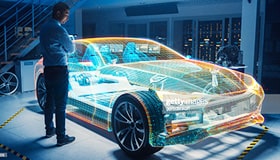Powering up with safety and ease: the art of EV charger design
As we seek more sustainable forms of transport, the advantages of electric vehicles (EVs) are becoming increasingly clear.
The success of electric vehicles depends largely on ensuring that EV drivers can charge their vehicles conveniently, either through home charges or at charging stations in towns, cities and at filling stations. EV charger design therefore requires consideration of where they are sited, how they are used, charging times and voltages, usability, safety, communications and security.
Where are electric vehicles charged?
Electric vehicles are charged at two types of site. The first is a destination charger, usually sited at facilities such as a carpark, shopping centre or other city centre site or at home. These use slow AC chargers.
The other is an en-route charger, often sited at filling stations along the highway. These employ high power, fast DC chargers that can provide accelerated charge times.
Charging standards and speeds
There are three main types of chargers:
- Fast chargers
- Rapid chargers
- Home points
Fast chargers
Most of the public chargers being installed are ‘fast chargers’, essentially a wall mounted socket or a post with a pair of sockets. Charging can take several hours from ‘fast chargers’, but many EV drivers often simply require a ‘top-up’ charge and may plug in for an hour or so. Because of this, the occupancy of these chargers is unpredictable duration, requiring a certain amount of a flexibility of use.
Rapid chargers
Because rapid chargers deliver charge at a higher current, they will therefore charge a vehicle faster than ‘fast chargers’, delivering around about 80% of the charge the car needs in the first 30 to 40 minutes. However, battery chemistry means they cannot fully charge a car at this same high rate - while it is possible to fully charge the car on a ‘rapid charger’ it will take over an hour. This is therefore an inefficient use of a ‘rapid charger’ and should be discouraged. They are also more expensive and require a higher capacity electrical connection. With a cable incorporated into the charger, they are similar in appearance to conventional petrol pumps.
Home charging
Home chargers are generally used off road on driveways and home garages. Charging generally takes place overnight using off-peak electricity. Some use captive cables, while others are essentially that make use of the vehicle’s portable cable. Charging at work may be undertaken in a variety of ways although many businesses are installing home or fast chargers.
Connector types
Car charging cables generally have two connectors, one that plugs into the vehicle socket and the other into the chargepoint itself. Electric vehicles will have either a Type 1 or Type 2 socket for slow/fast charging or a CHAdeMO or CCS for DC rapid charging.
Most slow/fast chargepoints have a Type 2 socket, while all DC rapid charging stations have a cable attached with mostly a CHAdeMO and a CCS connector. Most EV drivers will purchase a portable charging cable to match their vehicle’s Type 1 or Type 2 socket to allow them to charge on public networks.
There are currently eight different connector standards in use, across AC and DC – varying from brand to brand and region to region.
EV charging station components

Figure 1: Components of a typical EV charger – source TTI
An EV charging station will typically comprise an electric vehicle charger, power grid, a facility meter, an energy controller, a software platform, the network operating center, power storage and several other relevant components. These latter will consist of user interfaces, network connectivity and components to handle charge management and billing.
Energy storage for EV charging
The power storage system at an EV charging station consists of three main units: battery, the power conversion system, and software.
The batteries are mainly lithium-ion batteries, consisting of cells and a battery management system (BMS) to control charging and discharging, while the power conversion system consists of an inverter and enclosure, and a HVAC system to maintain the battery at a specific temperature.
Electric vehicle charging software helps connect and monitor the charger, aids automatic fault detection, provides a live meter display, handles billing and payments, tracks costs and manages users, amongst other things.
Safety components
Safety is of paramount importance for users of EV chargers, particularly as many will not have experience of such high voltages. Today’s typical EV chargers deliver 400V to 1,000V of DC power, potentially presenting safety threats from both electrical shock, usually as the result of a ground fault) and overcurrent.
A ground-fault protection device uses a current transformer on the phase conductors. This ensures that all current coming from the source returns on the same conductors. A ground fault in the system will return current through this path. Ground-fault protection is also required at the output side to avoid having drivers picking up a potentially live nozzle. This is achieved using a DC ground-fault monitor to detect an earth leakage and shut off power instantly.
EV charging stations need high voltages to meet the current demands and numbers of vehicles using them but allowing that power to exceed normal levels can produce many undesirable consequences – overheating systems, damaged insulation and even injury or death to users.
The solution is to select fuses based on their interrupting capacity, their rating based on normal operating current and their time-current curve. Such current limiting fuses operate quickly in the event of a high-value overcurrent.
Overcurrent protection is particularly important for semiconductors which are sensitive to electricals threats. These semiconductors are typically based on silicon and silicon carbide. Although conventional fuses are adequate to protect most of these, special high speed DC fuses are required to protect power semiconductor devices such as MOSFETS and IGBTS used in power converters.
Power conversion
Power conversion is a crucial element in DC fast charging systems. Minimizing losses in power conversion ensures that the maximum possible amount of power is to the vehicle’s batteries – this also helps reduce heat build-up within systems.
Power semiconductor devices convert AC power into the DC power needed by the vehicle’s batteries. The semiconductor devices control the charging through switching, which inevitably results in power losses as heat.
To meet this challenge, advanced power converters are increasingly based on silicon carbide (SiC) and gallium nitride (GaN) technology. The two major technologies in this area are SiC (Silicon Carbide) and GaN (Gallium Nitride).
SiC is a compound semiconductor composed of silicon and carbide. SiC power semiconductors can be used for much higher power device voltages than traditional silicon, ranging from 600V to thousands of volts. The technology is typically used in high power applications and offers lower switching losses and lower cost.
Gallium Nitride (GaN) is a very hard and mechanically stable semiconductor. A GaNFET will offer a much higher breakdown strength, faster switching speed, higher thermal conductivity and lower resistance than silicon based equivalents.
As well as handling much higher voltages than silicon, their high speed switching also makes them particularly suitable for battery management in electric vehicles.
Ergonomic aspects
One of the major aspects of EV charger design is their usability – to ensure that EVs achieve the number of sales to sustain a viable market, users must be confident that chargers are easy to use and also that their data is secure.
This encompasses various aspects. One of the main considerations is cables and sockets. These need to have and ergonomically designed plug handle, with minimal resistance when a user needs to extend and manoeuvre the cable. Cables should also need to be a suitable length to reach the sockets on different vehicle models.
Other considerations include height and location of the charge point and cables to ensure safe operation by all users, sufficient illumination to allow night time use, payment options that are suitable for the chosen market, simple pricing structures and open access without eh need for a subscription or registration process.
Communications and connectivity
Easy, reliable and secure communications with the charge point are vital for both charge management and accurate billing.
Chargepoints generate a lot of data, which can include the chargepoint ID, the plug-in time and date, unplug time and date, and the total energy drawn in kilowatt hours.
Driver details such as payment method, account number and amount spent on the charging session will also be recorded. Data may also be required to accommodate ‘smart charging’, where the charger communicates with the car, the charging facility and the electric utility to optimize charging and avoid the need for expensive upgrades to the supply.
Various protocols are used for data exchange. The most basic communications protocol used in Type 1 and 2 AC charging systems between the charger and the vehicle is IEC 61851, which exchanges information such as when the charging starts, stops and the current the car draws.
OCPP is a global standard for charger communication with a back office. Created by the Open Charge Alliance (OCA), the specification has both required and optional features, ranging from basic charger control to high level security and reservations.
Because of this mass of data, achieving excellent, reliable connectivity – between the EV chargepoints, with the user and with the internet - is a must.
There are three main options here – hardwired, Wi-Fi or cellular.
Hardwired methods have the speed, capacity and reliability to handle the data exchanges needed, but the amount of cabling required to connect potentially widespread charters could make the method impractical.
Wi-Fi is another option. Although avoiding extensive cabling, Wi-Fi has vulnerabilities to power outages, radio interference and malicious attacks.
Cellular gives each chargepoint access to mobile phone networks. Offering comprehensive coverage, high reliability and robust security, cellular is an ideal solution for connecting chargepoints.
Conclusion
The number of EV chargers is set to grow significantly, but they need to meet certain criteria if they are to have the confidence of both charge point operators and users. By taking account of the need for safety, efficiency, usability and connectivity, as well as accurate billing, EV charger designers can ensure the success of their products and contribute to the growth of the overall EV market.
Stay informed
Keep up to date on the latest information and exclusive offers!
Subscribe now
Thanks for subscribing
Well done! You are now part of an elite group who receive the latest info on products, technologies and applications straight to your inbox.








